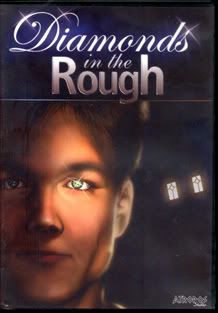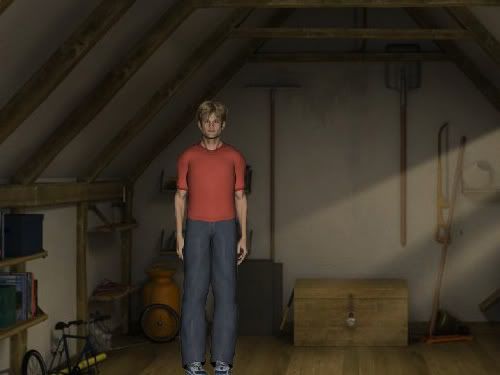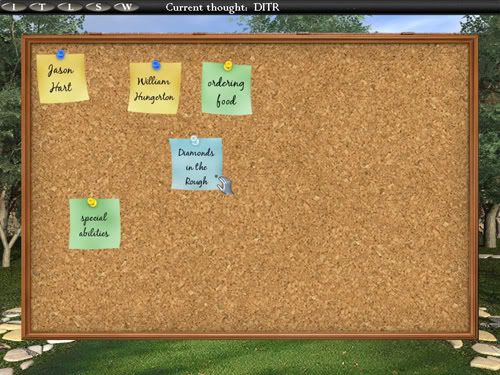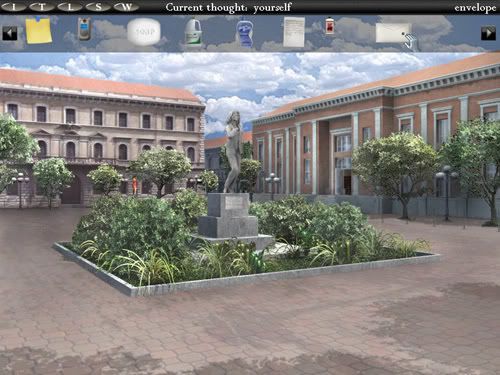
Diamonds in the Rough
Genre: Adventure
Developer: Atropos Studios
Publisher: Atropos Studios
Release Date: 03/18/2008
Today I feel like a true member of the Diehard Gamefan writing staff for the first time. Yes, I’m going through that traditional rite of passage all writers here must be a part of by reviewing my first obscure low-budget adventure game! Ahhh, I’m misting up a bit as I type this.
Anyways, Diamonds in the Rough is the first game from new Greek developer Atropos Studios and is written/designed by the guy who single-handedly developed the cult favorite freeware adventure Other Worlds. So far a small handful of sites devoted to adventure games have bestowed largely glowing reviews upon this title, but is this merely a case of people being pleasantly surprised that a game made with very limited resources is actually decent or have Atropos Studios managed to produce a true top-level adventure game?
1) Story
Near the end of DitR (which I’ll refer to the game as from now on so as to limit finger strain) your main character takes a dose of yellow phosphorous leaving him with only a couple torturous hours to live. Re-checking the beginning of this paragraph to see if you missed a spoiler warning? There’s not one there because this is actually the first thing you learn when you start up the a new game, as right from the beginning DitR announces it’s intention to present a story that’s a little different. Maybe even a bit challenging.
The rest of the game takes place in flashback form as you take control of Jason Hart, a young man from a rough background who happens to have limited psychic abilities. If presented with a question with multiple answers, Jason has the ability to always choose the answer the person who asked the question wants him to choose. Jason is recruited by Diamonds in the Rough, an organization lead by a William Hungerton and relocated to a small, isolated compound/town whose residents all posses special abilities. All Jason has to do is take part in occasional tests of his powers and he’s provided with anything he could possibly want, except information about Diamonds in the Rough’s true purpose that is. That information quickly becomes Jason’s number one desire when he discovers a vaguely sinister message carved into an old desk by the man who lived in his house before him…
“We aren’t diamonds, we’re only pieces of coal.”Â
The set-up for DitR is quite unique, the little town is populated by an interesting cast characters and despite being written by someone for whom English isn’t a first language, and the dialogue is pretty sharp. It’s not perfect, most people from non-English speaking countries that try to write in English don’t realize that North Americans speak a formless mush of contractions, half pronounced, blended-together words and stupid phrases we picked up from rap videos, and as such the dialog in DitR sounds a bit inauthentic at times. Whether that’s a good or bad thing is up to you.
Where DitR’s story succeeds best though is in creating a constant lingering sense of unease. There’s no intestine chomping zombies, no cackling villains or shambling genital shaped abominations and yet right from the beginning there’s a palatable sense there’s something not right about this seemingly idyllic town. Discovering the aforementioned “pieces of coal” message is a genuinely off-putting moment, and later in the game when you find a couple drops of blood on a bathroom floor you’ll feel like you’ve been punched in the gut. Games like Ninja Gaiden can spend countless hours and dollars developing the perfect blood-spurting neck wound and gamers simply shrug their shoulders then move onto the next hyper-violent action game, while DitR manages to create a truly disturbing moment with a couple red dots on a bathroom floor. Now that’s the power of a well-built story.
A lot of other reviews of this game mention a twist ending, leading me to question whether these reviewers actually know what “twist ending” means. Granted the ending of the game is definitely surprising, even a bit shocking, but it’s in a “wow, are they really going there with this story?” sense, not because of any twist. I wasn’t sure what I thought about the ending at first. Given the somewhat surreal feeling of most of the story I guess I was expecting the DitR organization’s sinister motivations to be more cosmic or supernatural in nature, when instead they’re rooted in our real and sometimes very ugly world. In retrospect though, I have to give the writer of DitR credit for tackling such challenging subject matter. You simply wouldn’t see anything like this in a mainstream game. In an interesting move the writer even includes a message you can read after you beat the game explaining his motivations, writing processes and research methods, which puts the ending in the proper context (and at the same time will scare the shit out of you with the information that some of the characters in the game were actually based on real people).
Bottomline Diamonds in the Rough’s storyline is one of the most intriguing I’ve experienced in years and is without a doubt the most worthwhile aspect of the game.
Story Rating: Classic
2) Graphics
Now I know I just wrote that this game creates a sense of unease mostly through it’s well crafted story rather than packing the game with hideous freaks, but I may have to take that back…

Argh, God! Kill it, kill it with fire! Yes, this game is filled with such abominations. Characters with strange, twisted, anatomically incorrect appendages that bend and flex in ways human limbs weren’t intended to. Dead soulless eyes stare out at you; their bodies remaining eerily stalk still as they talk, as if they’re waiting to strike. Brrrrrr.
Just in case I’m not making this clear enough, the DitR character models? Really, really, really ugly. Like, really. The environments are comparatively much better looking in that they’re merely static, bland and low-res as opposed to a borderline heath hazard.
Graphics Rating: Dreadful
3) Sound
Now unlike the visuals the audio in DitR is actually pretty good. The music is simple and often seems to be incongruous to the settings or situation, but that actually adds to the vaguely off-putting, surreal vibe of the game.
Surprisingly given this is a Greek game the English voice acting is also solidly done, or at least the male voices are. The female voices are largely lousy, the most noticeable poor performance being the girl doing your best friend Sydelle’s voice. She’s a major character who you hear from a lot and the performance is mostly stilted with the actress doing a poor job of concealing some sort of accent (it doesn’t sound Greek, but then I’m no linguist). This seems to be a common issue with video games actually. When it comes to the male voice actors they hire guys who can actually, you know, act, but when it comes to casting the female parts they just grab anyone with boobs who works in the office then plunk them in front of a microphone. Maybe it’s some sort of desperate game designer seduction technique.
“Hey sweetheart, why don’t you come over to my place? We can have a few drinks then if the mood strikes you maybe we can, well you know…record some lines for my indy adventure game. I’ll make you a star honey, a star!”Â
Ahem, what were we talking about again? Oh right. DitR music = very good, voice acting = average. Moving on.
Sound Rating: Good
4) Control and Gameplay
Diamonds in the Rough is a point-and-click adventure game, but even though you interact with everything simply by clicking on it this game is presented in a 3rd person perspective instead of 1st person style like Myst. This is kind of needless, as having Jason wandering around onscreen accomplishes nothing other than to slow down the gameplay and offend gamers’ eyes with his ugliness. A 1st person perspective would have allowed them to streamline things and hide their severe limitations where creating 3D models is concerned, but oh well.
If you’ve used a computer sometime within the last 15 years you should be able to get your head around controlling DitR just fine. You simply use the left mouse key to click on anything you want to interact with and the right mouse key to scroll through your pointer’s various functions (walk, examine, use, talk, use item/thought). The game requires you to constantly scroll through the functions and it starts to become rather annoying quickly, particularly since many of the functions could have been combined (there’s really no reason examine, use and talk had to be separate functions). This incessant scrolling through the functions is exacerbated by the fact that you can’t simply open up your inventory and click on an item to select it, you have to switch to the “use” function in order to grab it. This is completely needless.
The gameplay here will be pretty familiar to anyone who’s played an adventure game before. You wander around a smallish world, pump people for information and haul a backbreaking load of trinkets around that you’ll use and combine to solve puzzles in order to progress. It’s pretty standard stuff with the one major addition to the mix being the Thoughts Panel.

Occasionally while talking to someone, reading something or examining an item a light bulb will appear over your head and a new thought will be added to your Thoughts Panel. By selecting one of these it will become Jason’s current thought, but unfortunately the mechanic is not quite as interesting as you might hope. Your current thought has no effect on how you act or respond to people, you’ll reply to other characters in the same way regardless of if you’re thinking about the sinister doings of the Diamonds in the Rough organization or cupcakes. Instead the thoughts are simply used as a 2nd inventory. Once you select a thought it will be represented as a sticky note which you can show to people to trigger new conversations, apply to items or areas on screen to help solve puzzles or even combine with inventory items or other thoughts to create new thoughts. So there’s a fair amount of depth to it, but honestly the Thoughts Panel often just makes the game more complicated rather than more fun. As just one example, in most current adventure games if you have a new objective new conversation branches will simply automatically appear when you talk to people. Not here, instead you have to fish around in your Thoughts Panel for the right thought to show them in order to get some new information, which makes me think “pain in the ass” more than “innovative”Â.
This “make things needlessly complicated” approach is really applied to the majority of the game’s puzzles. This game doesn’t really serve up much in the way of satisfyingly clever mind teasers, most of the challenge in DitR comes from the game simply withholding information or being frustratingly vague about things. For instance at one point in the game you have to get an object out of your closet which should be easy for anyone who isn’t, you know, a bug-eating moron. But of course this is an adventure game, so your main character is a bug-eating moron and can’t find anything in his own closet because the light is burned out. Okay fine, I’m used to adventure games where the guy tasked with saving the world is barely smart enough to dress himself, so I’ll accept he needs to order a light bulb to locate things a foot in front of his face in his own closet. No hint about how to order said light bulb is given, you’re simply sent off to randomly scour the area in a process that’s more frustrating than fun. This kind of thing happens a lot in the game. Also in order to trigger events you often have to complete totally unrelated tasks the game doesn’t inform you of. Want to get a guy to appear in the park for a clandestine meeting? Well, make sure you combined two thoughts in the Thoughts Panel, talked to some random kid, and delivered a specific envelope (none of which has much of anything to do with meeting this guy). The makers of the game simply decided you had to have this, this and that done in order to progress to the next step in the game. Would be lovely if they’d actually tell players that.
Now I’m sure a small selection of old-school adventure game fanatics may enjoy this kind of stuff, but those of us who don’t think adventure games should stay forever mired in the same needlessly obtuse gameplay we were putting up with in the 20 years ago will mostly be annoyed.
Control and Gameplay Rating: Mediocre
5) Replayability
As with most adventure titles, if you know what you’re doing you could probably blow through this game in an hour or two. That said the game’s vagueness and relatively high level of challenge will significantly lengthen your experience (personally it took me around 10 hours to complete the game). 10 hours is actually pretty decent for an adventure game, but once you’re done you’re done. There’s no incentive to play through again and I expect most people won’t, as the game’s annoyances will only be more noticeable when you’re no longer distracted by wondering what’s going to happen next in the story.
Replayability Rating: Mediocre
6) Balance
DitR is definitely more difficult than your average current day adventure game, but for the most part it chugs along at a pretty steady high, but manageable level of difficulty. That is, until you careen headfirst into the brick wall that is the password puzzle. This brain breaking frustration-fest requires a migraine-inducing array of steps and questionable leaps of logic to complete. Good puzzles should stimulate you and make your feel smart when you solve them. This puzzle makes you feel stupid and when you finally slog through it you mainly just feel like punching the guy who designed it. So yeah, the game’s actually pretty well balanced with one big glaring pimple-on-prom-night exception.
Balance Rating: Mediocre
7) Originality
Gameplay-wise this game is mostly very standard stuff, with the Thoughts Panel sounding interesting but not adding a whole lot to the game. I do have to give it points for it’s unique and challenging storyline though even if the actual gameplay is strictly by the book.
Originality Rating: Mediocre
8) Addictiveness
This game is very hot and cold when it comes to addictiveness. When you’re on a roll, knocking down the puzzles and revealing the story at a decent rate the game will grab you and hours will disappear without you noticing. On the other hand, when you find yourself lost due to the game’s stubborn insistence on denying you guidance all the game’s flaws become much more noticeable. If I hadn’t sworn a solemn blood oath to Gamefan cult leader Alex Lucard to review this game on time it definitely would have been put on the backburner after a few of the more brain breaking sections.
Addictiveness Rating: Decent

9) Appeal Factor
Most people are going to take one look at this game and not give it the slightest chance. Everything about it screams low-budget indy game and just like most people would rather watch the latest “Adam Sandler makes a funny voice for 90 minutes” movie than a quality independent film, the vast majority won’t give this one a 2nd look. It doesn’t help that it’s an adventure game either, as it’s a cult genre at best these days. I don’t expect this one to spread much beyond the community of true adventure game fanatics.
Appeal Factor Rating: Awful
10) Miscellaneous
You feel kind of bad beating up on a low-budget independent game like this. It’s like that poor kid in elementary school…sure he sported a bowl-cut, wore the same clothes for 2 months straight and his lunch each day was nothing but an old hot dog bun and a slice of processed cheese, but it’s wasn’t really his fault. I respect the makers of Diamonds in the Rough for telling a challenging story, attempting to do something a little bit different and just generally trying to make a fairly ambitious game without a lot of resources. In some respects they actually succeeded big time and I’d like to see what Alkis Polyrakis and the folks at Atropos Studios cook up in the future.
Miscellaneous Rating: Enjoyable
The Scores
Story: Classic
Graphics: Dreadful
Sound: Good
Control and Gameplay: Mediocre
Replayability: Mediocre
Balance: Mediocre
Originality: Mediocre
Addictiveness: Decent
Appeal Factor: Awful
Miscellaneous: Enjoyable
Final Score: Mediocre Game
Short Attention Span Summary
You know it’s one thing to review a Grand Theft Auto IV or Smash Bros. Brawl and report that, shock of shocks, these games are in fact good. It’s another and more satisfying thing altogether I think to discover that great obscure game, that diamond in the rough (see what I did there?) and help give it some much-needed exposure. I was hoping this would be that game, but despite an excellent story it just has too many issues weighing it down to recommend to anyone but the most dedicated of adventure game fans. Then again, they’re probably the only people who would go out of their way to track this game down anyways, so I suppose it all works out in the end.
Leave a Reply